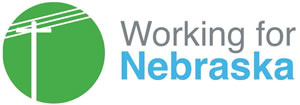
Early last year Perennial hired a rate consultant to provide a cost-of-service study and a rate design to ensure cost-correct rates for our customers. Utility Financial Solutions (UFS) worked closely with management analyzing several metrics including financial data, revenue details, historic billings, system asset inventories, load data, and other records. After UFS completed the cost-of-service and rate design, the Perennial Board of Directors and management reviewed the findings and the board voted to make the rates effective, October 1st of this year.
What’s In the Cost
to Serve You?
There are three major components required to deliver power to your service every day of the year and at any given moment. Let’s start at the beginning with generation and transmission.
Wholesale power costs can be divided into two components, generation and transmission. The cost for generation, or the production of electricity includes fuel cost, maintenance of generators, and investments in power plants whether maintaining Gerald Gentleman Station near Sutherland, renewing a nuclear license for Cooper Nuclear Station, or building new generation near Sheldon Station. The other component we can’t neglect is transmission costs. Transmission costs are also recovered through Perennial’s monthly wholesale bill and cover the costs of building and maintaining transmission lines. These lines deliver energy from the generators to transmission substations. Generation and transmission costs account for approximately 70 percent of your monthly electricity bill.
These costs are shared among the wholesale customers of Nebraska Public Power District (NPPD), and NPPD’s retail customers. We expect substantial rate increases in Perennial’s wholesale power bill in the next two to three years driven by generation additions and transmission improvements. This summer NPPD will publish their rate outlook with the generation, transmission and auxiliary costs. With these rate changes we will review our financial projections and adjust rates to cover costs.
The third and final component is distribution costs, which make up the remaining 30 percent of your power bill. These are the costs associated with the Perennial subtransmission lines, distribution substations, distribution power lines, trucks, operation overheads and the employees that keep
all 7,800 meters energized and serving our customers.
In the last 7 years Perennial has seen transformer costs increase 140 percent, poles have increased 76 percent, and total operations costs have increased 37 percent. As you might have expected, inflation has been the main driver of these increases.
How Do these Costs Change My Electric Bill?
Rates can only follow the costs to keep your power reliable. The combined average rate increase for Perennial customers this October will be 4.9 percent, residential rates will range from a 5 to 9.5 percent increase and the highest increase of 15.1 percent is required for irrigation re-use pump services. Your percent increase will depend on the amount of energy consumed and your peak demand each month.
Why is There a Charge for Demand?
As our electric grid evolves and the need for electric power increases it is necessary to consider the demand required to serve each customer. Demand is a measurement of power and is commonly expressed as a kilowatt (kW), and equal to 1.3 horsepower. The peak demand is the highest average demand for one 15-minute interval during the billing period. When you receive your residential, general service, or commercial electric bill for the month of October you will see an additional line showing a demand charge of $0.50 per kW. So, if your peak demand was 11 kW then you would pay $5.50 for the demand charge that month. Demand charges are a more accurate way to assess costs related to wholesale power supply and it also reduces subsidizing other types of services.
Increasing rates to cover costs helps us serve you. Through the recent spring blizzard, or hot summer weather, remember that we’re committed to providing safe, reliable, and affordable power to your homes and businesses.

